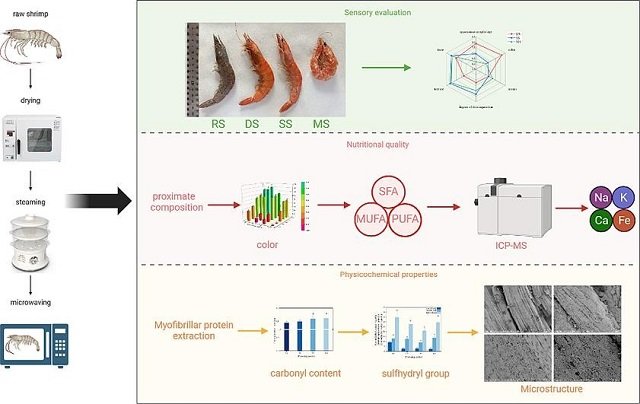
The Pacific white shrimp (Penaeus vannamei) is one of the most consumed seafood worldwide, prized for its delicate texture and rich flavor. But did you know that the way you cook your shrimp can significantly affect its flavor, texture, and even its nutritional value?
Two recent studies have provided insights into how different cooking methods (drying, steaming, and microwaving) affect these characteristics, helping consumers make informed decisions.
Nutritional and Physicochemical Changes
The first study, published in Food Chemistry (Zhang et al., 2024), explored how drying, steaming, and microwaving affect the nutritional and physicochemical properties of Penaeus vannamei. The research revealed that the shrimp’s water-holding capacity is the main component affected by these thermal processes.
The scientists tested three processing methods:
- Drying (DS, 120°C for 40 min)
- Steaming (SS, 100°C for 2 min)
- Microwaving (MS, 600 W for 2 min)
The study found that the fatty acid ratio in the microwave-heated and dried samples more closely aligned with the health recommendations set by FAO/WHO. This suggests that these methods might be better choices for health-conscious consumers.
Additionally, thermal processing induced protein oxidation, as indicated by an increase in carbonyl groups in myofibrillar proteins and a decrease in sulfhydryl content. The degree of oxidation varied by method, ranked from highest to lowest as: microwaving, steaming, and drying. This oxidation not only affects nutritional value but also impacts the shrimp’s texture and color.
Flavor Profile Alterations
The second study, published in LWT – Food Science and Technology (Zhang et al., 2024), delved into how these processing methods alter the flavor profile of Penaeus vannamei. Using advanced techniques like electronic tongue, electronic nose, and gas chromatography-ion mobility spectrometry (GC-IMS), the study analyzed volatile and non-volatile flavor compounds.
Key findings include:
Stay Always Informed
Join our communities to instantly receive the most important news, reports, and analysis from the aquaculture industry.
- Non-volatile compounds: Thermal processing increased the levels of sweet free amino acids, 5′ nucleotides, and organic acids. Aspartic acid, glutamic acid, succinic acid, guanine nucleotide, and hypoxanthine nucleotide emerged as the primary active flavor components.
- Volatile compounds: A total of 38 volatile compounds were identified, including alcohols, esters, aldehydes, ketones, acids, and others. The dried and microwave-heated samples exhibited a richer and more diverse flavor profile compared to the steamed ones.
Principal component analysis further highlighted distinctive flavor differences between the processed samples, with the dried and microwave-heated shrimp being tastier than the steamed ones. This suggests that drying and microwaving not only preserve but may even enhance the flavor complexity of Penaeus vannamei.
Choosing the Right Method for You
Based on these studies, it is clear that cooking methods significantly influence the flavor, texture, and nutritional profile of white shrimp. Here’s a quick guide to help you choose:
- For a lighter texture and maximum nutrient retention: Steaming is a good option.
- For a richer, “umami” flavor and potentially healthier fat profile: Drying might be a good choice.
- For more intense aroma and a varied flavor profile: Microwaving or drying may be your preference.
Conclusion
The choice of thermal processing method has a substantial impact on both the nutritional and sensory qualities of Penaeus vannamei. For consumers looking to maximize the health benefits and flavor experience of their shrimp, microwaving and drying appear to be superior methods. These findings provide valuable guidance for those seeking to enjoy shrimp that is both nutritious and flavorful.
By understanding how different cooking techniques affect the qualities of Penaeus vannamei, consumers can make better-informed decisions, ensuring that their culinary choices align with their nutritional and sensory preferences.
References
Zhang, C., Shi, R., Liu, W., Xu, Z., Mi, S., Sang, Y., Yu, W., & Wang, X. (2024). Effect of different thermal processing methods on sensory, nutritional, physicochemical and structural properties of Penaeus vannamei. Food Chemistry, 438, 138003. https://doi.org/10.1016/j.foodchem.2023.138003
Zhang, C., Shi, R., Mi, S., Chitrakar, B., Liu, W., Xu, Z., Sang, Y., Yu, W., & Wang, X. (2024). Effect of different thermal processing methods on flavor characteristics of Penaeus vannamei. LWT, 191, 115652. https://doi.org/10.1016/j.lwt.2023.115652
Editor at the digital magazine AquaHoy. He holds a degree in Aquaculture Biology from the National University of Santa (UNS) and a Master’s degree in Science and Innovation Management from the Polytechnic University of Valencia, with postgraduate diplomas in Business Innovation and Innovation Management. He possesses extensive experience in the aquaculture and fisheries sector, having led the Fisheries Innovation Unit of the National Program for Innovation in Fisheries and Aquaculture (PNIPA). He has served as a senior consultant in technology watch, an innovation project formulator and advisor, and a lecturer at UNS. He is a member of the Peruvian College of Biologists and was recognized by the World Aquaculture Society (WAS) in 2016 for his contribution to aquaculture.




